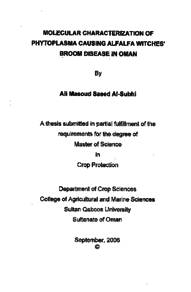وثيقة
Molecular characterization and genetic diversity of phytoplasmas in Oman using multiple genes analyses and functional genomics of SAP11
الناشر
Sultan Qaboos University
ميلادي
2018
اللغة
الأنجليزية
الملخص الإنجليزي
Witches' broom of alfalfa (Medicago sativa L.) is a serious disease caused
by a phytoplasma in the Al-Batinah, Al-Sharqiya, Al-Dhahera, and interior regions of the Sultanate of Oman. Disease incidence was recorded to be 95% in 6 year-old
alfalfa crop during field survey. Phytoplasma bodies were detected by 4,6
diamidino-2-phenylindole (DAPI) staining in alfalfa plants showing witches' broom
symptoms. Results obtained from transmission electron microscopy revealed the
presence of numerous phytoplasma cells in phloem sieve-tube members in
diseased plants but not in healthy tissues. Total nucleic acid isolated from
symptomatic alfalfa was used as template to amplify 16S-23S ribosomal DNA and
spacer region by polymerase chain reaction (PCR) using two pairs of universal
primers as direct (P1/P7) and nested (R16F2n/ R16R2). The PCR amplifications yielded 1.8 and 1.2 kb fragment from direct and nested PCR respectively from DNA of symptomatic alfalfa, Restriction fragment length polymorphism (RFLP) profiles of direct PCR products amplified from symptomatic alfalfa and 19 phytoplasmas from different groups used as positive control with Tsp5091, Rsal, Tagl, Trugl, and Hpall restriction enzymes clearly indicated that alfalfa phytoplasma is different from all other phytoplasmas employed in this study
belonging to subgroup 16Srll, except tomato big bud (TBB) phytoplasma from Australia, and could be therefore classified in TBB subgroup, 16Srll-D. The P1/P7 PCR product was sequenced after cloning and yielded 1690 bp product. The alfalfa witches' broom (AlfWB) phytoplasmsa showed >98% similarity with papaya yellow crinkle (Papaya YC) phytoplasma from New Zealand in the homology search and <98% similarity with LWB phytoplasma. These finding were supported by phylogenetic analysis that showed AllWB clustering with FBP group (16Srll) and PapayaYC belonging to the same group. On the basis of results obtained from restriction fragment length polymorphism and nucleotide sequence analyses of 16S rDNA, the AlfWB phytoplasma was classified in FBP group (16Srll), designated subgroup II-D.
الوصف
Thesis
المجموعة
URL المصدر
الملخص العربي
مرض مكنسة الساحرة من الأمراض الخطيرة و المدمرة التي تصيب القت (البرسيم العماني في كل من المناطق التالية: الباطنة و الشرقية و الداخلية و الظاهرة، الفايتوبلازما (بكتريا بدون جدار خلوي) هي التي تسبب هذا المرض، و أظهر المسح الميداني لحقول القت أن نسبة الإصابة بمرض المكنسة تصل إلى 95% في الحقول التي تكون أعمارها من ست سنوات و أكثر. لقد تم الكشف عن وجود الفايتوبلازما في القت المصاب باستخدام صبغة ( diamidino - 2 - DAPI -4) ), 6 phenylindoleو ذلك بانبعاث ضوء اللصف (Fluorescence) من الخلايا الغربالية المصابة، و صور المجهر الإلكتروني أظهرت و جود عدد كبير من خلايا الفايتوبلازما في الخلايا الغربالية للقت المصاب فقط المزيد من التأكد و لمعرفة نوع الفايتوبلازما فقد تم استخدام التقنية الحيوية في دراسة مرض مكنسة الساحرة في القت العماني، تم استخلاص الحمض النووي (DNA) من النباتات المصابة لاستخدامه في تحليل تفاعل البلمرة المتسلسل (PCR)، بواسطة تفاعل البلمرة المتسلسل تم تضخيم جين (16S rDNA) للفايتوبلازما و ذلك باستخدام زوجين من البادئات (Primers)، في التفاعل الأول أو المباشر (Direct PCR) تم استخدام البادئة المتحدة ( P1 / P7) و لمزيد من الدقة استخدمت البادئة المتحدة ( R16F2n/ R16R2) في التفاعل الثاني (Nested PCR) و لقد تم تضخيم الحمض النووي من العينات المصابة فقط وكانت (kb 1 . 8) من (Direct PCR) و (kb 1 . 2) من ( Nested PCR حسب المتوقع استخدمت تقنية تباين أطوال قطع الحمض النووي المقطعة بإنزيمات القطع المحدود (RFLP ) لمخرجات ( Direct PCR) لعينات القت المصاب و 19 عينة من الفايتوبلازما من مجموعات مختلفة كعينات موجبة ( positive control )، استخدم في عملية القطع الأنزيمات التالية ( Tsp509 , Rsal , Taql , Tru9l , and Hpall)، إشارة نتائج التحليل (RFLP ) إلى وجود فروق بين فايتوبلازما مرض مكنسة الساحرة في القت العماني مع كل الفايتوبلازما المستخدمة ، إلا أنه وجد تشابه مع فيتو بلازما (tomato big bud ) من استراليا و لهذا تم تصنيف الفيتو بلازما التي تصيب القت العماني من ضمن مجموعة ( 16Sr
قالب العنصر
الرسائل والأطروحات الجامعية

